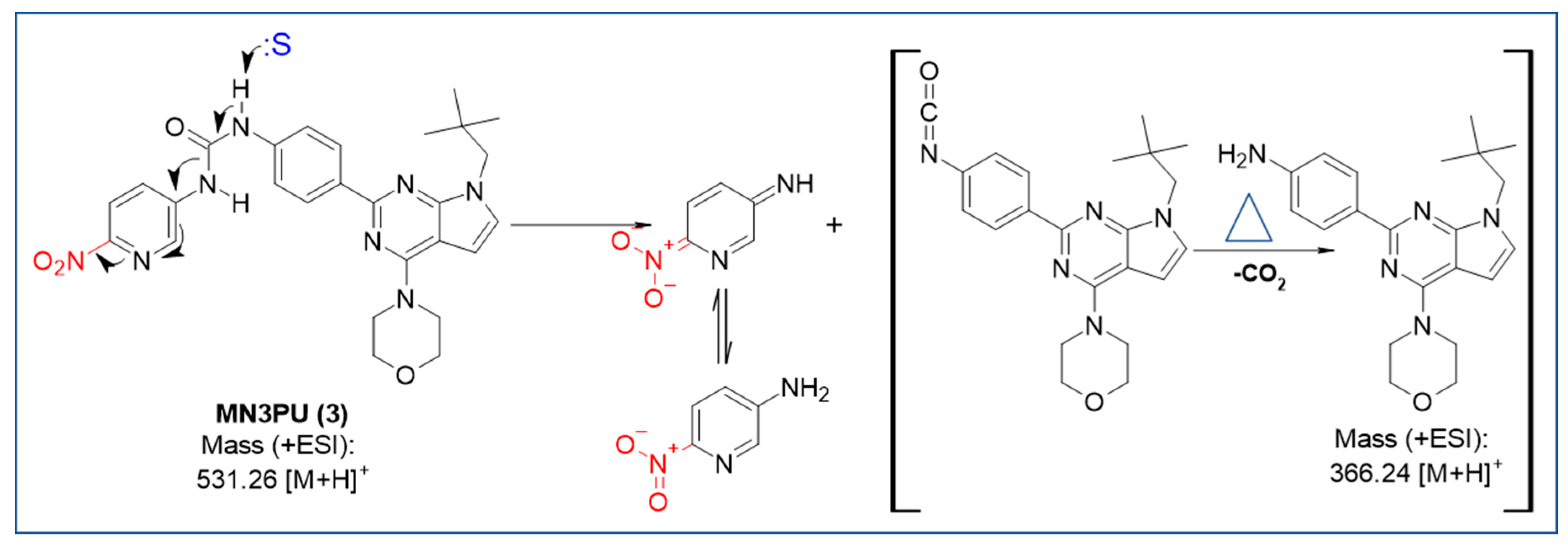Lewis Acid-Facilitated Radiofluorination of MN3PU: A LRRK2 Radiotracer
Abstract
1. Introduction
2. Results
3. Discussion
4. Materials and Methods
4.1. General
4.2. Chemistry
4.2.1. Urea Formation
4.2.2. [18F]Fluoride Production
5. Conclusions
Supplementary Materials
Author Contributions
Funding
Acknowledgments
Conflicts of Interest
References
- Scott, J.H.P.; Hockley, B.G. Radiochemical Syntheses: Radiopharmaceuticals for Positron Emission Tomography; John Wiley & Sons. Inc.: Hoboken, NJ, USA, 2012; Volume 1, pp. 1–155. [Google Scholar]
- Beyzavi, M.H.; Mandal, D.; Strebl, M.G.; Neumann, C.N.; D’Amato, E.M.; Chen, J.; Hooker, J.M.; Ritter, T. 18F-Deoxyfluorination of Phenols via Ru π-Complexes. ACS Cent. Sci. 2017, 3, 944–948. [Google Scholar] [CrossRef] [PubMed]
- Xu, P.; Zhao, D.; Berger, F.; Hamad, A.; Rickmeier, J.; Petzold, R.; Kondratiuk, M.; Bohdan, K.; Ritter, T. Site-Selective Late-Stage Aromatic [18F]Fluorination via Aryl Sulfonium Salts. Angew. Chem. Int. Ed. 2020, 59, 1956–1960. [Google Scholar] [CrossRef]
- Orlovskaya, V.V.; Modemann, D.J.; Kuznetsova, O.F.; Fedorova, O.S.; Urusova, E.A.; Kolks, N.; Neumaier, B.; Krasikova, R.N.; Zlatopolskiy, B.D. Alcohol-Supported Cu-Mediated 18F-Fluorination of Iodonium Salts under “Minimalist” Conditions. Molecules 2019, 24, 3197. [Google Scholar] [CrossRef]
- Dollé, F. Fluorine-18-labelled fluoropyridines: Advances in radiopharmaceutical design. Curr. Pharm. Des. 2005, 11, 3221–3235. [Google Scholar] [CrossRef]
- Shen, B.; Löffler, D.; Reischl, G.; Machulla, H.-J.; Zeller, K.-P. Nucleophilic substitution of nitro groups by [18F]fluoride in methoxy-substituted ortho-nitrobenzaldehydes—A systematic study. J. Fluor. Chem. 2009, 130, 216–224. [Google Scholar] [CrossRef]
- Malik, N.; Solbach, C.; Voelter, W.; Machulla, H.-J. Nucleophilic aromatic substitution by [18F]fluoride at substituted 2-nitropyridines. J. Radioanal. Nucl. Chem. 2009, 283, 757–764. [Google Scholar] [CrossRef]
- Chen, Z.; Venkatesan, A.M.; Dehnhardt, C.M.; Ayral-Kaloustian, S.; Brooijmans, N.; Mallon, R.; Feldberg, L.; Hollander, I.; Lucas, J.; Yu, K.; et al. Synthesis and SAR of Novel 4-Morpholinopyrrolopyrimidine Derivatives as Potent Phosphatidylinositol 3-Kinase Inhibitors. J. Med. Chem. 2010, 53, 3169–3182. [Google Scholar] [CrossRef]
- Kuryla, W.C. Dipolar solvents in polyurethane foams. J. Appl. Polym. Sci. 1965, 9, 1019–1040. [Google Scholar] [CrossRef]
Sample Availability: Not available. |
Publisher’s Note: MDPI stays neutral with regard to jurisdictional claims in published maps and institutional affiliations. |




| Experiments (n = 4) | Conventional (Reaction Conditions-b) | Lewis Acids (Reaction Conditions-c) | ||
|---|---|---|---|---|
| Chromium II Chloride (A) | Ferric Nitrite (B) | Titanocene Dichloride (C) | ||
| 90 °C (25 min) | 1.7 ± 0.7% | 41 ± 1% | 10 ± 1.2% | 37 ± 0.7% |
© 2020 by the authors. Licensee MDPI, Basel, Switzerland. This article is an open access article distributed under the terms and conditions of the Creative Commons Attribution (CC BY) license (http://creativecommons.org/licenses/by/4.0/).
Share and Cite
Malik, N.; Bendre, S.; Schirrmacher, R.; Schaffer, P. Lewis Acid-Facilitated Radiofluorination of MN3PU: A LRRK2 Radiotracer. Molecules 2020, 25, 4710. https://doi.org/10.3390/molecules25204710
Malik N, Bendre S, Schirrmacher R, Schaffer P. Lewis Acid-Facilitated Radiofluorination of MN3PU: A LRRK2 Radiotracer. Molecules. 2020; 25(20):4710. https://doi.org/10.3390/molecules25204710
Chicago/Turabian StyleMalik, Noeen, Shreya Bendre, Ralf Schirrmacher, and Paul Schaffer. 2020. "Lewis Acid-Facilitated Radiofluorination of MN3PU: A LRRK2 Radiotracer" Molecules 25, no. 20: 4710. https://doi.org/10.3390/molecules25204710
APA StyleMalik, N., Bendre, S., Schirrmacher, R., & Schaffer, P. (2020). Lewis Acid-Facilitated Radiofluorination of MN3PU: A LRRK2 Radiotracer. Molecules, 25(20), 4710. https://doi.org/10.3390/molecules25204710







